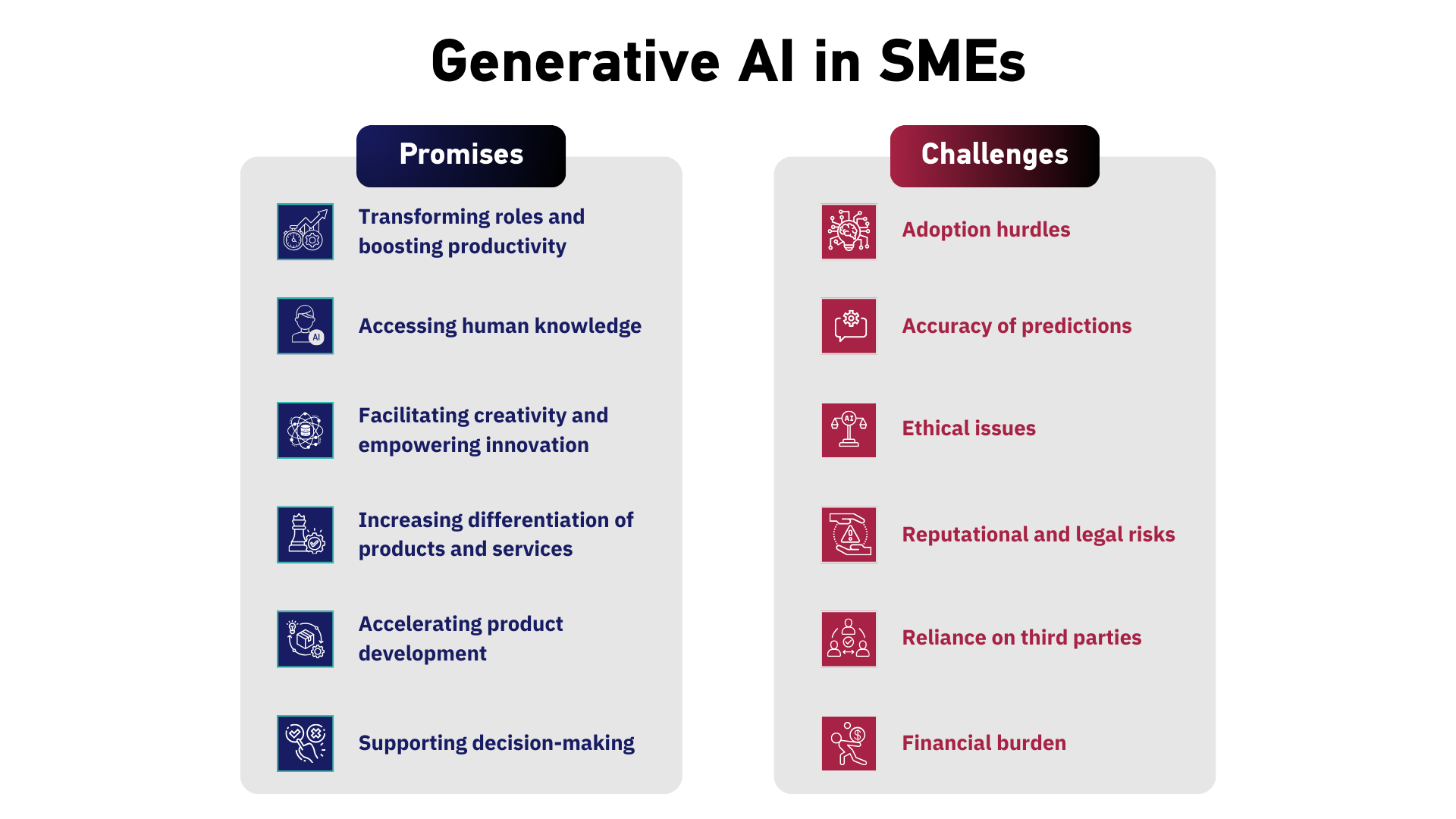Navigating Promises and Challenges of Generative Artificial Intelligence in SMEs

Small and medium enterprises (SMEs) increasingly adopt emerging technologies to remain competitive and grow in today’s rapidly evolving landscape. One such advancement is generative artificial intelligence (GenAI)—a powerful tool that creates content by analysing patterns from extensive training datasets. This technology is now becoming accessible to businesses of all sizes. From automating content creation to improving customer service and operations, GenAI transforms how SMEs operate.
In their insightful study, Dr Kumaran Rajaram (Nanyang Technological University) and Dr Patrick Tinguely (ETH Zurich) examined how SMEs can leverage the transformative power of GenAI to enhance scalability, foster creativity, and drive innovation. They also used a sailing metaphor to help SMEs navigate the core strategic dimensions necessary for GenAI's effective and successful deployment.
“GenAI is the first technology in history to create its own content rather than disseminate or support created by humans. This breakthrough is set to disrupt how SMEs operate, particularly impacting jobs that involve non-routine and complex tasks.”, said Dr Kumaran.
Promises and Challenges of GenAI
A notable strength of GenAI is the automatic generation of content, including advances in language modelling (e.g., ChatGPT), and image generation from text descriptions (e.g., Midjourney). The study outlined six promises of GenAI for SMEs: transforming roles and boosting productivity, accessing human knowledge, facilitating creativity and empowering innovation, increasing differentiation of products and services, accelerating product development, and supporting decision-making.
 Despite its promises, GenAI presents challenges arising from the algorithms behind it or how SMEs adopt such technology. For instance, marketing professionals may be reluctant to use GenAI to design advertising visuals, as they strongly identify with such tasks. Another significant challenge is that GenAI can produce inaccurate or false outputs and present them as true or reliable.
Despite its promises, GenAI presents challenges arising from the algorithms behind it or how SMEs adopt such technology. For instance, marketing professionals may be reluctant to use GenAI to design advertising visuals, as they strongly identify with such tasks. Another significant challenge is that GenAI can produce inaccurate or false outputs and present them as true or reliable.
“The retail industry is exploring how GenAI can enhance operations, such as using facial recognition for remote shopping. However, this raises privacy, security, and ethical concerns about data usage and consent,” Dr Kumaran remarked on the challenges of employing GenAI.
The key challenges GenAI presents for SMEs can be classified as follows: adoption hurdles, accuracy of predictions, ethical issues, reputational and legal risks, reliance on third parties, and financial burden. In light of these challenges, SMEs must carefully consider how to integrate GenAI into their operations, ensuring proper safeguards are in place for successful adoption.
Navigating Deployment of GenAI in SMEs
To visualise their insights, the researchers developed a sailing metaphor in which SMEs are ships navigating the waters of a changing competitive landscape. The limited capabilities of SMEs show how they are ill-equipped to cope with uncharted waters. Therefore, GenAI creates an unprecedented disruption to the ships, i.e., SMEs, which requires them to constantly adapt their approach to stay afloat.

The sailing metaphor focuses on key strategic dimensions that guide SMEs to effectively and successfully deploy GenAI. The four dimensions are (1) competency of employees, (2) effective leadership and work values, (3) organisational culture, collaboration and cooperation, and (4) relationships with third parties. Therefore, by addressing these strategic dimensions, SMEs can better navigate the challenges posed by GenAI.
Practical Recommendations for SMEs
Drawing from the sailing metaphor, the study offers practical recommendations for successfully deploying GenAI in SMEs. Firstly, firms are recommended to design the right ecosystem to upskill their workforce and seek expertise beyond the SME. Next, leaders should communicate a clear vision and empower employees for GenAI development. SME leaders must also become powerful change agents in promoting the novel possibilities of GenAI.
Third, SMEs should nurture an organisational culture that embraces technological adoption, and address GenAI challenges through collaboration and cooperation. Lastly, SMEs must decide the degree of reliance on third-party providers, choosing between a take-or-shape approach while deploying GenAI. The take approach uses cost-effective off-the-shelf solutions, while the shape approach customises GenAI to perform specific tasks in niche areas with better relevance and accuracy.
“It is crucial to understand how humans can work with GenAI to enhance efficacy and effectiveness. Rather than dismissing security concerns as a risk, the focus should be on creatively mitigating those issues. As a leader, it is important to recognise the challenges and the nuances that may arise in the process.”, said Dr Kumaran on the implications of his research.
Note: This research paper was published by Business Horizons (ScienceDirect) in September 2024.
Dr. Kumaran Rajaram is a Senior Lecturer with the Leadership, Management and Organisation Division at the Nanyang Business School, Nanyang Technological University. He specialises in Global Leadership and International Management, where he lectures, leads a team of senior instructors and is responsible for the curriculum & learning design of management and leadership courses. He is also a CRADLE Fellow with the Centre for Research and Development in Learning, where he performs cutting-edge research in organisational & management science, people & culture, leadership, emerging technologies (Gen AI/AI) in organisations, Gen AI in learning and assessments learning analytics, culture of learning & learning culture and internationalisation of business higher education.

